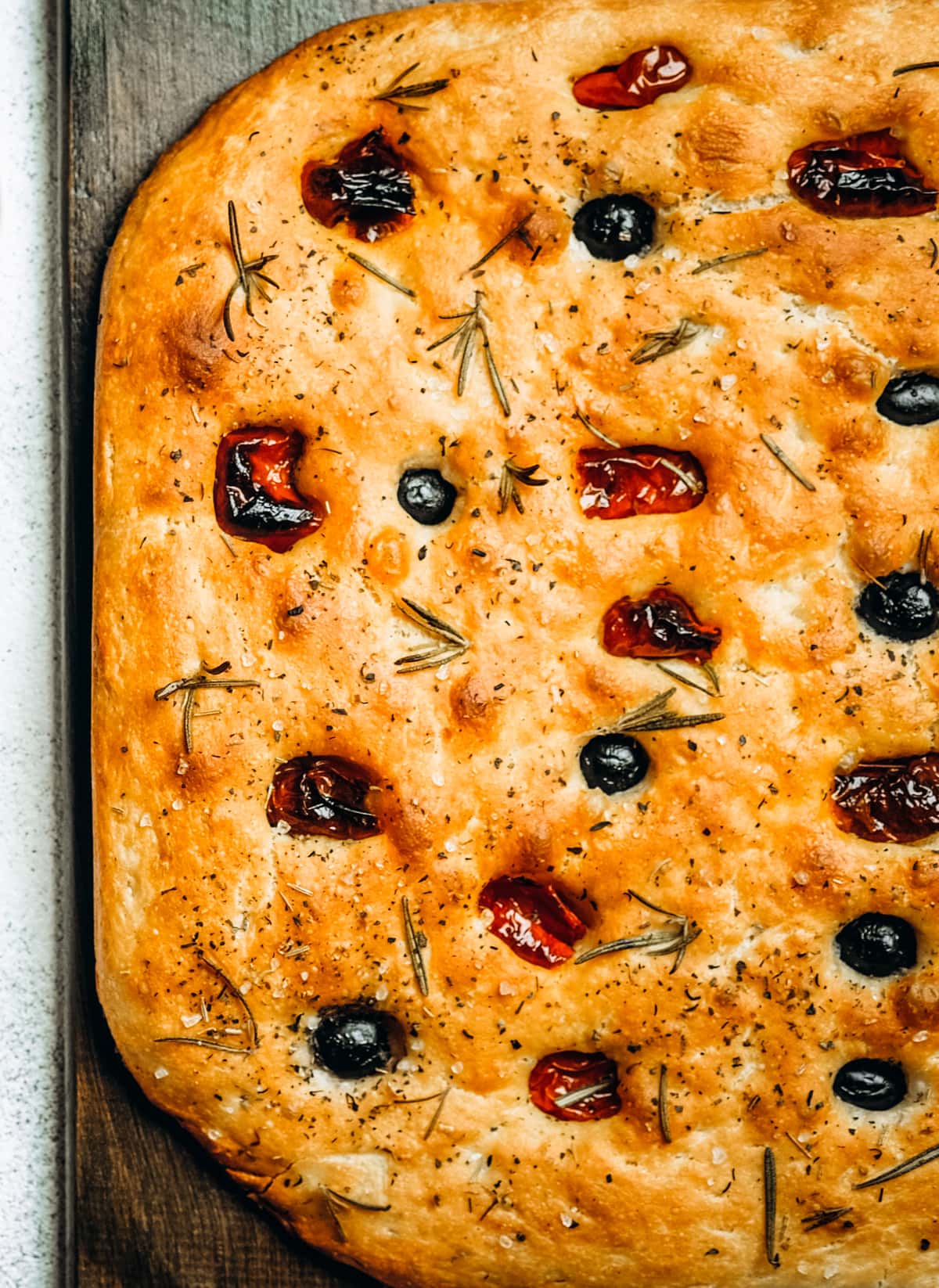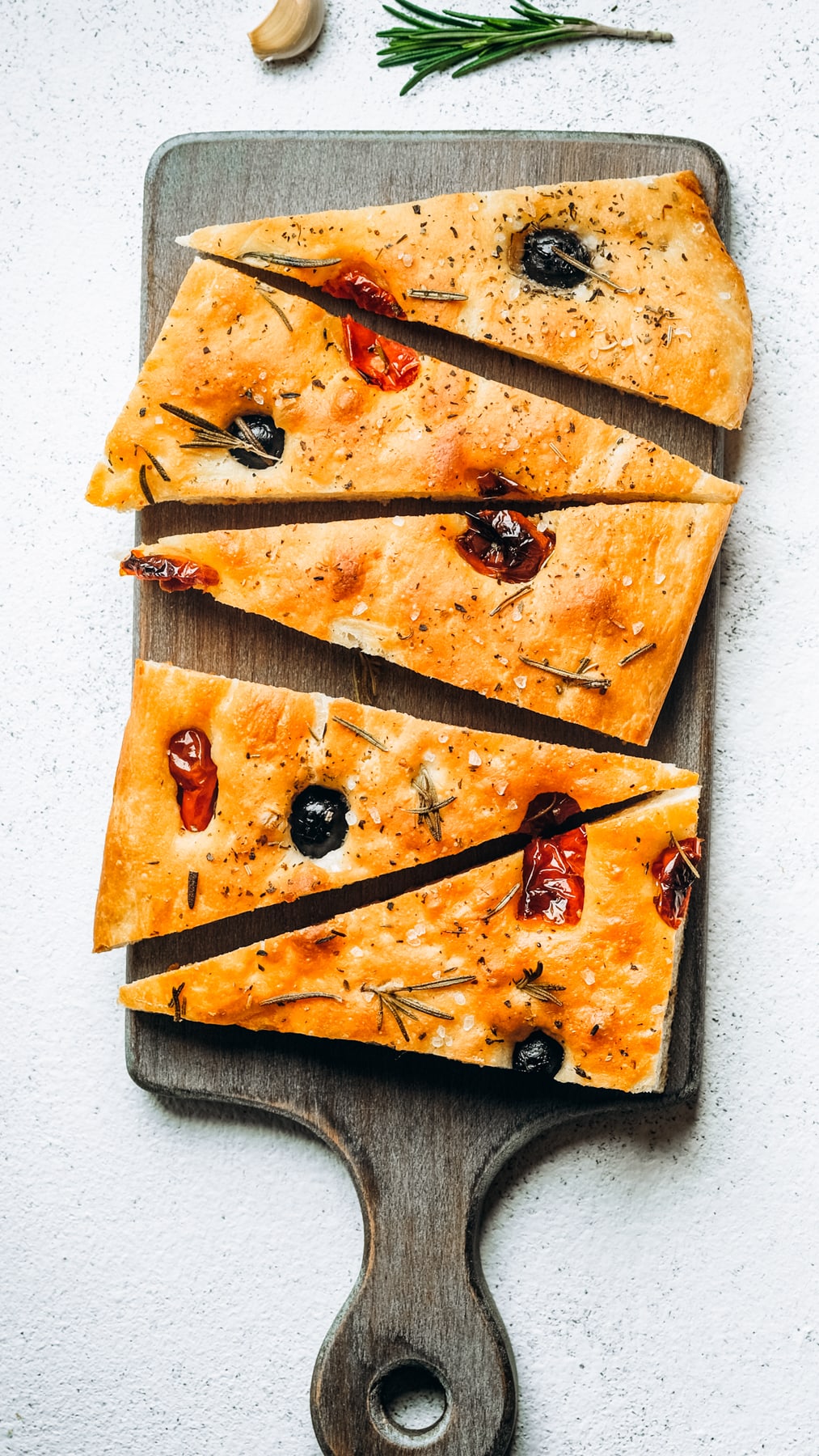Discover the secrets to making focaccia bread, enhanced with the robust taste of tomatoes and olives. The bread’s crispy exterior and chewy interior will make it a favorite in your kitchen.

Focaccia Bread Recipe
Focaccia bread, a staple of Italian cuisine, carries the essence of the Mediterranean with every bite. Known for its olive oil-infused texture, golden crust, and herbs, this flatbread has won the hearts of bread enthusiasts worldwide. The recipe I am sharing is unique because I’ve incorporated tomatoes and olives, which add depth and complexity to the traditional Focaccia. The saltiness of the olives, combined with the sweet and tangy taste of the tomatoes, creates one damn amazing piece of crusty bread! Once you’ve got the hang of it, you’ll find yourself making it over and over again!
What Is Focaccia Bread?
The origins of Focaccia bread can be traced back to ancient times, with various cultures putting their unique spin on this bread. In ancient Rome, “panis focacius” was a flatbread cooked on a hearth or fireplace, and its name likely derives from the Latin word “focus,” meaning hearth.
Focaccia is such a great and easy bread to make. It can be made thick or thin, crunchy on top or not, but it is almost always soft in the center. I like mine baked to a nice golden brown with coarse salt and other savory ingredients sprinkled on top and served with a mix of olive oil and balsamic vinegar for dipping.

Why You’ll Love This Recipe
- Versatility: Serve this bread as an appetizer, a side dish, or even a main course. Focaccia pairs beautifully with salads, soups, and various entrées.
- Customizable: The basic recipe is just the beginning. You can experiment with different toppings like caramelized onions, minced garlic, shredded Parmesan, or fresh herbs to make it your own.
- Simple Ingredients: Made with pantry staples like bread flour, olive oil, yeast, and coarse salt, this recipe doesn’t require any exotic or hard-to-find ingredients.
- Texture Perfection: With a golden crust on the outside and a soft, chewy inside, this focaccia offers a texture that’s irresistible. The dimpling technique ensures the olive oil and toppings infuse every bite.
How To Make Focaccia Bread
This great recipe adapted from one I discovered long ago is easy to make and delicious with whatever you choose to put on it. I don’t include measurements for the toppings because you can add whatever amounts you like—some people like a few ingredients scattered on top, and some like it piled high. Remember to scroll down the page to the recipe card for full recipe instructions.
Ingredients For Focaccia
- rapid rising dry yeast
- warm water
- sugar
- bread flour
- coarse salt
- olive oil
- cornmeal
- toppings: olives, sun-dried or roasted tomatoes, caramelized onions, etc…

Directions
- Prepare the Dough: Proof the yeast in the bowl of a stand mixer by combining it with the sugar and warm water. Stir to dissolve. Let stand for 3 minutes. Incorporate bread flour and mix with the dough hook attachment. The dough should be smooth and elastic.
- Shape and Let Rise: Form the dough into a round and let it rise until doubled in size.
- Prepare the Pan: Grease a jelly roll pan with olive oil and sprinkle with cornmeal.
- Add Toppings: Roll and stretch the dough, then dimple with your fingertips. Add olive oil, coarse salt, slow-roasted tomatoes, Kalamata olives, and any optional toppings you desire.
- Bake: Bake at 400˚F for 15 to 20 minutes or until browned on top.
Tips For Focaccia Success
Making homemade focaccia can be a fun experience, and here are some additional tips to ensure success!
- Bread Flour: Bread flour is typically used in focaccia for its higher protein content, which creates a chewier texture. If you can’t find bread flour, all-purpose flour can be a substitute, but the texture may vary slightly.
- Use Warm Water: This is important; the water must be warm, between 105˚F and 115˚F, to create the perfect environment to activate the yeast, setting the stage for a successful rise and a textured bread.
- Patience with Rising: Allowing the dough to double in size is essential for a light, airy texture.
- Kneading Technique: Whether kneading by hand or using a mixer, achieving the right texture is key. The dough should be smooth, elastic, and slightly sticky. If kneading by hand, using a pushing and folding motion can help develop the gluten structure.
- Dimpling Technique: Before baking, use your fingertips to create dimples in the dough. This not only adds texture but also allows the olive oil and toppings to permeate the bread.
- Quality Ingredients: Using sun-dried tomatoes or carefully slow-roasting your own can enhance the flavor.
- Customization: Feel free to play around with the toppings. Add minced garlic, fresh herbs, or shredded Parmesan for an extra punch of flavor.
- Avoid Overcrowding with Toppings: While it’s tempting to load up on delicious toppings, too many can make the bread soggy. A balanced approach will result in the best texture and flavor.

How To Serve Focaccia
Focaccia is versatile; it can be paired with various dishes and dips. Here’s how you can enjoy it:
- Olive Oil and Balsamic Vinegar: Serve your focaccia with a mix of olive oil and balsamic vinegar. The rich, fruity olive oil combined with the tangy sweetness of balsamic vinegar creates a dipping sauce that enhances the bread’s flavors.
- With Soup or Salad: Focaccia makes an excellent side to hearty soups or fresh salads. Try it with my White Bean Soup and this Tomato Salad.
- As a Sandwich Base: Use it as a base for sandwiches, filled with your favorite cold cuts, cheeses, and vegetables for a Mediterranean-inspired meal.
- Alongside Pasta: Serve it with pasta dishes like my Chicken Pasta Primavera!
- With Cheese and Charcuterie: Create a simple yet elegant appetizer by serving focaccia with a selection of cheeses, cured meats, and olives.
- As a Pizza Alternative: Top with fresh tomatoes, mozzarella, and basil, then briefly bake for a quick and tasty focaccia pizza.

Storage
- If the focaccia is only topped with olive oil and herbs, you can keep it at room temperature sealed in a ziplock bag or in an airtight container. However, if the focaccia is like mine here, topped with tomatoes and olives, then you’ll want to keep it in the fridge for 3 to 4 days.
ENJOY!
-
Preheat oven to 400˚F.
-
Proof the yeast in the bowl of a stand mixer by combining it with the sugar and warm water. Stir to dissolve. Let stand 3 minutes or until foam appears.
-
Using a dough hook attachment, turn the mixer on low and slowly add the flour to the bowl.
-
Dissolve the salt in 2 tablespoons of water and add it to the bowl while the mixer is running.
-
Pour in 1/4 cup olive oil.
-
When the dough starts to come together, increase the speed to medium.
-
Mix until the dough is smooth and elastic, about 10 minutes, adding flour as necessary.
-
Turn out the dough onto a work surface and fold over itself a few times.
-
Form the dough into a round and place it in an oiled bowl; turn to coat the entire ball with oil.
-
Cover with a damp towel and let it rise in a warm spot until doubled in size, about 45 minutes.
-
Grease a jelly roll pan with olive oil and sprinkle it with corn meal.
-
Once the dough is doubled and domed, turn it out onto the counter.
-
Roll and stretch the dough out to an oblong shape about 1/2-inch thick.
-
Place dough on the pan and cover with plastic wrap. Let rest for 15 minutes.
-
Uncover the dough and dimple it with your fingertips.
-
Brush the surface with more olive oil and then add your toppings.
-
Bake for 15 to 20 minutes or until browned on top.
-
Remove from oven and turn onto a cooling rack; let stand a few minutes before cutting and serving.
- Choose the Right Flour: Bread flour is typically used in focaccia for its higher protein content, which creates a chewier texture. If you can’t find bread flour, all-purpose flour can be a substitute, but the texture may vary slightly.
- Monitor Water Temperature: The water used to proof the yeast should be warm but not hot, usually between 105°F to 115°F (37°C to 43°C). If the water is too hot, it can kill the yeast, while if it’s too cool, the yeast may not activate.
- Kneading Technique: Whether kneading by hand or using a mixer, achieving the right texture is key. The dough should be smooth, elastic, and slightly sticky. If kneading by hand, using a pushing and folding motion can help develop the gluten structure.
- Proper Rising Environment: Place the dough in a warm and draft-free spot to rise. If your kitchen is cool, you can create a warm environment by turning on the oven for a minute or two, then turning it off and placing the dough inside to rise.
- Use Fresh Yeast: If using active dry or rapid-rising yeast, make sure it’s fresh, as expired or old yeast can fail to rise.
- Dimpling Technique: Before baking, use your fingertips to create dimples in the dough. This not only adds texture but also allows the olive oil and toppings to permeate the bread.
- Quality Olive Oil: Since olive oil is a significant flavor in focaccia, using extra virgin olive oil of good quality will enhance the taste.
- Experiment with Toppings: Don’t be afraid to get creative with your toppings. In addition to the classic ones, you could try roasted vegetables, different cheeses, or even a sprinkling of sea salt flakes.
- Watch the Baking Time: Oven temperatures can vary, so keep an eye on the focaccia as it bakes. Look for a golden-brown crust and use the baking time in the recipe as a guideline rather than a strict rule.
- Allow to Cool Before Cutting: Let the focaccia rest for a few minutes after it comes out of the oven. Cutting into it while it’s too hot may cause it to become gummy.
- Serve Fresh or Reheat Properly: Focaccia is best enjoyed fresh, but if you have leftovers, reheat them in the oven rather than the microwave to maintain the texture.
- Avoid Overcrowding with Toppings: While it’s tempting to load up on delicious toppings, too many can make the bread soggy. A balanced approach will result in the best texture and flavor.
Calories: 271 kcal | Carbohydrates: 43 g | Protein: 7 g | Fat: 8 g | Saturated Fat: 1 g | Polyunsaturated Fat: 1 g | Monounsaturated Fat: 5 g | Sodium: 585 mg | Potassium: 62 mg | Fiber: 2 g | Sugar: 3 g | Vitamin A: 1 IU | Vitamin C: 0.003 mg | Calcium: 10 mg | Iron: 1 mg | Net Carbs: 41 g
Nutritional info is an estimate and provided as courtesy. Values may vary according to the ingredients and tools used. Please use your preferred nutritional calculator for more detailed info.

